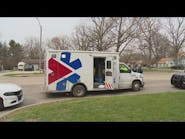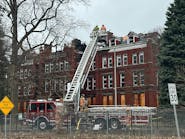During the past year I have received a number of requests from structural firefighters to write an article about basic wildland fire safety. Last year was a particularly deadly one for some structural firefighters that operated at wildland and wildland/urban interface fires (W/UI). Nearly a dozen structural firefighters became Line Of Duty Death (LODD) statistics at these types of fires. Many others received injuries that were minor to very serious. The LODDs resulted from a variety of causes, i.e., burn over; smoke inhalation; heart attacks; electrocution; vehicle accidents and one LODD from drowning. THE MOST IMPORTANT CONSIDERATION DURING ANY FIRE INCIDENT IS ALWAYS LIFE SAFETY, FIRST!
THE TEN (10) STANDARD FIRE ORDERS:
- Fight the fire aggressively but provide for safety FIRST.
- Initiate all actions based on current and anticipated fire behavior.
- Recognize current weather conditions and get weather forecasts.
- Ensure that instructions are issued and clearly understood by everyone.
- Obtain current information on fire's status.
- Remain in communications with your personnel, your supervisor/IC and other companies.
- Determine safety zone areas and establish escape routes.
- Establish lookouts in dangerous situations.
- Retain control at all times.
- Stay alert, keep calm, think clearly and act decisively.
THE EIGHTEEN (18)SITUATIONS THAT SHOUT "WATCH OUT!!"
- Fire is not sized up or scouted out.
- You are in an area not familiar to you or crew and not seen in daylight.
- Safety zones and escape routes have not been established or identified.
- You are not familiar with the weather and factors influencing it.
- Not informed of the tactics, strategy and hazards of incident.
- The instructions and assignments are not clearly understood.
- There are no communications with the firefighters or the officer/IC.
- The crew is constructing/cutting a fireline/fuel break without a safe anchor point.
- Constructing/cutting a fireline/fuel break downhill with fire burning below crew.
- Attempting a frontal fire attack.
- There are unburned fuels between you/crew and the fire.
- You cannot see the main body of fire and do not know where it is heading.
- Operating on a hillside where rolling materials can start a fire below you.
- The weather is getting drier and hotter.
- The winds are changing direction and/or increasing in speed.
- There are frequent spot fires igniting.
- The terrain and the vegetation can make escape routes and safety zones difficult to get to.
- You feel like taking a nap near the fireline.
WHAT IS L. A. C. E. S.?
- Look outs-Putting an experienced and trusted person where the fire can be seen is a must.
- Awareness-Be alert to what is happening around you. Look up, down and around.
- Communications-Are you able to communicate with the lookout(s), your crew and IC?
- Escape Routes/Safety Zones-Have these routes and zones been established, at least TWO, and does everyone know where they are?
APPARATUS OPERATIONS
While enroute to a fire incident: know the location of the fire; drive with care and caution considering the conditions of the road and traffic; drive as though EVERYONE'S life depended on your safe driving skills. At the scene: use extreme caution if heavy smoke is obscuring vision; watch for other apparatus; be alert for people and animals making a hasty evacuation in your direction; watch for escape routes and remember them; when parking apparatus keep away from vegetation if possible; back into a driveway or dead end road in case you may need to make a quick exit; when moving apparatus do it slowly and be sure no one is dangerously too close to its wheels; if there is no water supply, always leave about a quarter of the booster tank full for the crews protection. If you are the apparatus operator and you feel tired and groggy, let a more alert and qualified firefighter drive the apparatus back from the scene.
ELECTROCUTION
A LODD or injury from electricity is not a common factor, but it does occur from time to time. It can be a HIDDEN and insidious factor. Energized wires can be hidden in vegetation after falling from poles or from power line poles falling over. This can occur a long distance away and firefighters may be unaware of this potentially deadly and hidden danger. An energized power line might be laying on a long metallic fence a considerable distance away creating a dangerous and deadly situation should firefighters come in contact with it. Do NOT touch any fences at or near a fire scene. Use extreme caution if walking in high grass or brush. A live power line might be hidden in there. Do not drive under, park under or operate under power lines. And remember that some smoke can become a conductor of electricity.
VENEMOUS INSECTS & REPTILES
Use extreme caution in habitats of venomous snakes. The Gila Monster or Beaded Lizard is the only venomous lizard living in the southwestern deserts of the United States. Fire ants, spiders, scorpions, bees, hornets and wasps can all bite and sting. Seek medical aid if you've had an up close, personal and painful encounter with any of these critters. Especially seek IMMEDIATE aid if you are allergically sensitive as anaphylactic shock can rapidly occur creating a potentially life threatening medical emergency. If you become aware of a nest of one of these insects or reptiles, flag or tape off the area and notify your crew and the IC.
POISONOUS PLANTS
The common poisonous plants encountered are poison ivy, oak and sumac. Those people most commonly affected are allergic to the oils in these plants. However, when these plants burn they give off a toxic smoke that when breathed in can be extremely hazardous to those that are not normally allergic. Become familiar with what these plants look like.
HEARING PROTECTION
Hearing is very precious and is easily damaged by sirens, air horns, loud motors and loud radios. When in the vicinity of any of these high decibel-making devices, wear hearing protection.
SNAGS AND BURNED TREES
Snags or dead tree limbs are often called "widow makers" for justifiable reasons. They can and do kill firefighters. Trees, whether alive or dead, that have been burning at their respective bases or trunks over a long period of time can become weakened. They eventually fall over without much sound or warning. I once saw a large snag fall onto the trunk of a chief officer's car. The weight of the falling snag lifted up the front of the car with a very surprised driver sitting in it. The trunk was crushed. Hazardous areas where there are snags should be identified, taped off and the location conveyed to the crew and IC. And it is good safety advice to keep your helmet on your head when operating in not only burning areas of forests, but in areas that WERE burned.
YOUR PHYSICAL CONDITION
As we are well aware, structural firefighting is physically demanding work. Wildland firefighting is even more so. You should have very good to excellent aerobic capacity, physical strength and stamina to operate safely and effectively at wildland fires. People with known cardio-vascular problems must not directly participate in fire suppression operations. They can endanger not only themselves, but other firefighters as well. Know your physical limitations and don't exceed them, ever. Get a physical exam. Then, if you are okay to do so, work out and build up.
REHAB
Even the fittest and toughest of firefighters need to rest and rehab. Watch out for fatigue and heat stress. Heat stress can lead to heat stroke, which can become a true medical emergency. Do not consume soft drinks while at rehab. They contain high amounts of sugar and caffeine. Neither one are what your body wants or needs while under stress. Drink lots of water, pure fruit juices and high-energy drinks that replenish the body's nutrients. Keep your body hydrated by drinking lots of water BEFORE, DURING and AFTER fire suppression operations.
PROPER PERSONAL PROTECTIVE CLOTHING (PPE)
The wearing of the proper PPE while at wildland fires is essential and fundamental to safe operations. How many times do we see structural firefighters wearing those heavy turnouts, bunker gear, and rubber boots while working at wildland fires? Too many times.
Talk about developing heat stress, heat stroke, blisters and muscle strains!
If you and your fire service operate frequently at wildland fires, then the proper wildland PPE should be provided and worn. This includes: fire retardant station uniforms; all cotton underwear; wool or cotton socks; wildland turnout jacket and over pants; wildland helmet; eye protection; leather gloves; high top leather work boots; some form of filter respiratory protection (not SCBA); fire shelter, with the training to use it; and head shroud. That's the basic ensemble.
5 COMMON DENOMINATORS AT LODD FIRES
- Light fuels, i.e., grasses, weeds and brush can be deceptively dangerous.
- Incidents happened during small fires or in isolated areas of large fires.
- Fires that appeared as no big deal or under control that suddenly flared up.
- Fires occurring in gullies, steep slopes/hills and chimneys (not in houses) making fast unexpected runs uphill.
- During fires where air operations were used. The turbulence created by the rotor wash from a helicopter's blades or from a low flying airtanker can fan a small fire into a large one and engulf firefighters.
SIZE UP AND AWARENESS
Whether one is responding to a structural fire or a wildland fire, size up is very important and it should be the first thing that we do when a fire response is initiated. Some important aspects of wildland fire size up are: Life safety; time of the day/night; fire history, if any, in the area responding to; weather conditions-humidity, drought, wind speed and its direction; what's the fire look like, smoke amounts and color, flames and/or embers visible; structures in the area; water sources; access and egress; other apparatus responding and are there any Haz-Mats or power lines in the area.
Being aware of and practicing these basic safety fundamentals and other important factors are essential to safe and effective wildland fire suppression operations. Remember. Grass, brush and trees will always grow back. A structure can be rebuilt.
You and your fire crew are irreplaceable and safety first is no accident.





